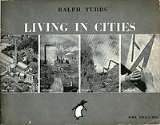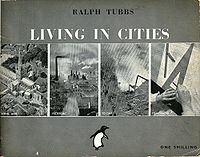
Ralph Tubbs
Encyclopedia
Ralph Tubbs, OBE
, FRIBA
(9 January 1912 – 23 November 1996) was a British
architect
. Well known amongst the buildings he designed was the Dome of Discovery
at the successful Festival of Britain
on the South Bank
in London
in 1951.
 Ralph was educated at the Architectural Association, which is highly regarded in Modern architecture
Ralph was educated at the Architectural Association, which is highly regarded in Modern architecture
and engineering
, and then worked for Ernö Goldfinger
from 1935 onward, participating in the design of Goldfingers house on 2 Willow Road
. In 1940 he designed the Living in Cities exhibition for the British Institute of Adult Education and the Council for Encouragement of Music and Arts, for which he made in 1942 a small book as well. During the World War II
, Tubbs was not in services for medical reason, and worked as firewatcher.
Buildings designed by Tubbs include (dates shown for design to building)
Ralph and his wife Mary Tubbs lived in Wimbledon Village
for most of their life. They had two sons and a daughter: Jonathan Tubbs, who is currently an architect in Wimbledon, James Tubbs, who is an engineer and Danielle who is a nurse. Ralph won many awards for his designs. His wife died in May 2007.
Ralph Tubbs's Dome of Discovery project was given tribute at the Millennium Dome
. In 1951, The Dome of Discovery was not only the largest diameter dome in the world, 365 feet across, but was totally unsupported except around the perimeter. Interestingly the Millennium Tent is 365 metres in diameter with supports absolutely all over and under it.
Order of the British Empire
The Most Excellent Order of the British Empire is an order of chivalry established on 4 June 1917 by George V of the United Kingdom. The Order comprises five classes in civil and military divisions...
, FRIBA
Royal Institute of British Architects
The Royal Institute of British Architects is a professional body for architects primarily in the United Kingdom, but also internationally.-History:...
(9 January 1912 – 23 November 1996) was a British
United Kingdom
The United Kingdom of Great Britain and Northern IrelandIn the United Kingdom and Dependencies, other languages have been officially recognised as legitimate autochthonous languages under the European Charter for Regional or Minority Languages...
architect
Architect
An architect is a person trained in the planning, design and oversight of the construction of buildings. To practice architecture means to offer or render services in connection with the design and construction of a building, or group of buildings and the space within the site surrounding the...
. Well known amongst the buildings he designed was the Dome of Discovery
Dome of Discovery
The Dome of Discovery was a temporary exhibition building designed by architect Ralph Tubbs for the Festival of Britain celebrations which took place on London's South Bank in 1951. The consulting engineers were Freeman Fox and Partners, in particular Oleg Kerensky The Dome of Discovery was a...
at the successful Festival of Britain
Festival of Britain
The Festival of Britain was a national exhibition in Britain in the summer of 1951. It was organised by the government to give Britons a feeling of recovery in the aftermath of war and to promote good quality design in the rebuilding of British towns and cities. The Festival's centrepiece was in...
on the South Bank
South Bank
South Bank is an area of London, England located immediately adjacent to the south side of the River Thames. It forms a long and narrow section of riverside development that is within the London Borough of Lambeth to the border with the London Borough of Southwark and was formerly simply known as...
in London
London
London is the capital city of :England and the :United Kingdom, the largest metropolitan area in the United Kingdom, and the largest urban zone in the European Union by most measures. Located on the River Thames, London has been a major settlement for two millennia, its history going back to its...
in 1951.

Modern architecture
Modern architecture is generally characterized by simplification of form and creation of ornament from the structure and theme of the building. It is a term applied to an overarching movement, with its exact definition and scope varying widely...
and engineering
Engineering
Engineering is the discipline, art, skill and profession of acquiring and applying scientific, mathematical, economic, social, and practical knowledge, in order to design and build structures, machines, devices, systems, materials and processes that safely realize improvements to the lives of...
, and then worked for Ernö Goldfinger
Erno Goldfinger
Ernő Goldfinger was a Hungarian-born Jewish architect and designer of furniture, and a key member of the architectural Modern Movement after he had moved to the United Kingdom.-Biography:Goldfinger was born in Budapest...
from 1935 onward, participating in the design of Goldfingers house on 2 Willow Road
2 Willow Road
2 Willow Road is part of a terrace of three houses in Hampstead, London designed by architect Ernő Goldfinger and built in 1938. It has been managed by the National Trust since 1995 and is open to the public. It was one of the first modernist buildings acquired by the Trust, giving rise to some...
. In 1940 he designed the Living in Cities exhibition for the British Institute of Adult Education and the Council for Encouragement of Music and Arts, for which he made in 1942 a small book as well. During the World War II
World War II
World War II, or the Second World War , was a global conflict lasting from 1939 to 1945, involving most of the world's nations—including all of the great powers—eventually forming two opposing military alliances: the Allies and the Axis...
, Tubbs was not in services for medical reason, and worked as firewatcher.
Buildings designed by Tubbs include (dates shown for design to building)
- 1935-1938 2 Willow Road2 Willow Road2 Willow Road is part of a terrace of three houses in Hampstead, London designed by architect Ernő Goldfinger and built in 1938. It has been managed by the National Trust since 1995 and is open to the public. It was one of the first modernist buildings acquired by the Trust, giving rise to some...
, HampsteadHampsteadHampstead is an area of London, England, north-west of Charing Cross. Part of the London Borough of Camden in Inner London, it is known for its intellectual, liberal, artistic, musical and literary associations and for Hampstead Heath, a large, hilly expanse of parkland...
, London - 1948-1951 Dome of DiscoveryDome of DiscoveryThe Dome of Discovery was a temporary exhibition building designed by architect Ralph Tubbs for the Festival of Britain celebrations which took place on London's South Bank in 1951. The consulting engineers were Freeman Fox and Partners, in particular Oleg Kerensky The Dome of Discovery was a...
, South BankSouth BankSouth Bank is an area of London, England located immediately adjacent to the south side of the River Thames. It forms a long and narrow section of riverside development that is within the London Borough of Lambeth to the border with the London Borough of Southwark and was formerly simply known as...
, London - 1952-1953 YMCA Indian Student Hostel, FitzroviaFitzroviaFitzrovia is a neighbourhood in central London, near London's West End lying partly in the London Borough of Camden and partly in the City of Westminster ; and situated between Marylebone and Bloomsbury and north of Soho. It is characterised by its mixed-use of residential, business, retail,...
, London - 1956-1961 Baden-Powell HouseBaden-Powell HouseBaden-Powell House, colloquially known as B-P House, is a Scouting hostel and conference centre in South Kensington, London, which was built as a tribute to Lord Baden-Powell, the founder of Scouting...
, KensingtonKensingtonKensington is a district of west and central London, England within the Royal Borough of Kensington and Chelsea. An affluent and densely-populated area, its commercial heart is Kensington High Street, and it contains the well-known museum district of South Kensington.To the north, Kensington is...
, London - Charing Cross HospitalCharing Cross HospitalCharing Cross Hospital is a general, acute hospital located in London, United Kingdom and established in 1818. It is located several miles to the west of the city centre in the London Borough of Hammersmith and Fulham....
, HammersmithHammersmithHammersmith is an urban centre in the London Borough of Hammersmith and Fulham in west London, England, in the United Kingdom, approximately five miles west of Charing Cross on the north bank of the River Thames...
, London - 1960 GranadaGranada TelevisionGranada Television is the ITV contractor for North West England. Based in Manchester since its inception, it is the only surviving original ITA franchisee from 1954 and is ITV's most successful....
House, ManchesterManchesterManchester is a city and metropolitan borough in Greater Manchester, England. According to the Office for National Statistics, the 2010 mid-year population estimate for Manchester was 498,800. Manchester lies within one of the UK's largest metropolitan areas, the metropolitan county of Greater...
Ralph and his wife Mary Tubbs lived in Wimbledon Village
Wimbledon, London
Wimbledon is a district in the south west area of London, England, located south of Wandsworth, and east of Kingston upon Thames. It is situated within Greater London. It is home to the Wimbledon Tennis Championships and New Wimbledon Theatre, and contains Wimbledon Common, one of the largest areas...
for most of their life. They had two sons and a daughter: Jonathan Tubbs, who is currently an architect in Wimbledon, James Tubbs, who is an engineer and Danielle who is a nurse. Ralph won many awards for his designs. His wife died in May 2007.
Ralph Tubbs's Dome of Discovery project was given tribute at the Millennium Dome
Millennium Dome
The Millennium Dome, colloquially referred to simply as The Dome or even The O2 Arena, is the original name of a large dome-shaped building, originally used to house the Millennium Experience, a major exhibition celebrating the beginning of the third millennium...
. In 1951, The Dome of Discovery was not only the largest diameter dome in the world, 365 feet across, but was totally unsupported except around the perimeter. Interestingly the Millennium Tent is 365 metres in diameter with supports absolutely all over and under it.

